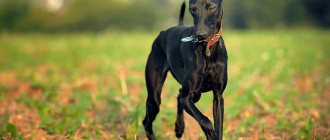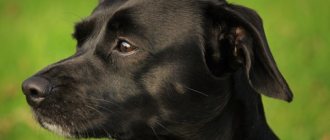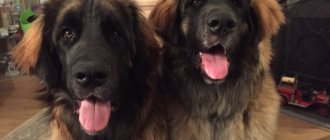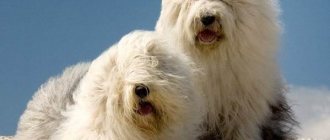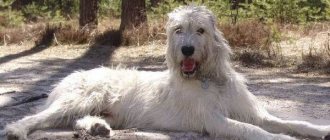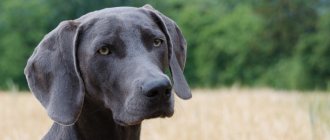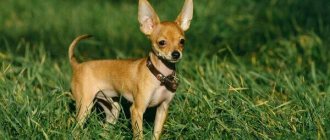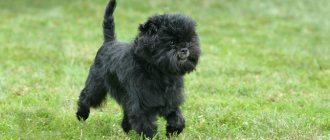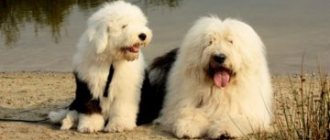An elegant aristocrat - there is no other way to call this sophisticated creature with an intelligent look and long paws. But the Greyhound is valued all over the world not only for its striking appearance and remarkable intelligence. He is recognized as the best runner, as he can run up to 67 kilometers per hour. This quality, plus the excellent skills of a born hunter, together make this breed one of the best hunting hounds.
History of the origin of the breed
The etymology of the name goes back to the English language, from which it is translated as “gray hound.” According to a less popular version, in Old English it was called a “crickhound”, that is, a “grasshopper dog” for its special body structure and high capabilities in running and jumping.
A truly known trace of its origin appears only in the 9th century AD. At this time, the Arabian Saluki breed was brought to England, which, to enhance its speed qualities, was mixed with local greyhounds bred by the Celts. The Greyhound has long been considered a privilege of the nobility, and lived exclusively in the castles of the real rich and royal families.
There is a well-known story about a dog named Ginofort, who saved his owner’s child from a snake in the cradle, but was killed by the owner, who decided that the dog had bitten the child. The owner was worried until the end of his life and even erected a monument to the pet.
Until the 18th century the breed did not improve, then grays were crossed with bulldogs to strengthen the body. Today, there are several “castes” within the breed that do not interbreed, since they have slight differences due to their main occupation: dogs for running, for hunting, for exhibition. Greyhounds were officially registered in 1986.
Appearance of the dog breed
When we say “Greyhound,” we most often mean the English variety.
- These are large dogs, with a height at the withers of about 70 cm and a weight of 30-40 kg.
- The physique is strong, fat mass is minimal.
- Thin paws and a large chest give the animal a lean, lean appearance.
- Strong muscles, a narrow muzzle and specifically set eyes make the breed dexterous hunters, able to quickly detect and catch nimble game.
The English greyhound has a relative - the Italian greyhound. Other names: Italian greyhound and small Italian greyhound. The height of the animal is 32-38 cm, weight is about 5 kilograms. The appearance of this greyhound is not much different from the larger greyhound variety.
The Italian greyhound, like the English greyhound, is primarily a hunting dog. Previously, they were used to catch rats in residential areas. However, due to its miniature size, the Italian greyhound is often considered as a companion and decorative pet. In the photo, the Greyhound dogs are a small breed, differing little from their larger counterparts.
Description of the breed
A large English greyhound reaches 70-80 centimeters in height and forty kilograms in weight. Has the following features:
- Elongated flat head with powerful jaws.
- Proportional, athletic body with well-developed muscles.
- Strong paws, powerful hips with enormous pushing power.
- Long thin tail with a characteristic bend in the middle.
- Colors: black, white, red, fawn (pale beige), brindle.
Greyhounds are the fastest dogs in the world. The Guinness Book of Records registered the official figure as 67 km/h. For this quality, the dog has the unofficial nickname “cheetah of the dog world.”
Breed standard
As mentioned before, greyhounds are very similar to Italian Greyhounds, which is easy to see in the photo. However, they should not be classified as the same breed. Indeed, despite the enormous similarity (which is why even Italian Greyhounds received the second name “ Italian Greyhounds ”), these two types of dogs have their own distinctive features.
A group of greyhounds on a walk in summer
So what are the breed standards? Greyhounds are characterized by a strong build and even muscularity, an elongated head, a long neck, a convex loin and, as befits a racing dog, strong legs. On average, an adult dog of this breed weighs approximately 26 to 40 kilograms. The approximate height of the female is 70 centimeters, the male is slightly larger - 74.
Thoroughbred Greyhounds will have a subtle transition between the forehead and muzzle, with particularly well-developed powerful jaws with strong white teeth. They typically have dark eyes and small, petal-shaped ears with short hair.
The paws of this breed are of medium length, on which it is easy to find dense pads all for the same comfort when running. Another feature of the breed is its long tail, which tapers towards the end. Usually dogs keep it slightly curved, trying not to raise it too far from the ground.
As for the coat, there is only one general rule: it is short, thin and close-lying. There are no strict restrictions in terms of color. Black, red, white, brown, brindle or any other color in combination with white. You can find a Greyhound to suit every taste.
Character and behavioral characteristics
The Greyhound is distinguished by specific temperamental traits that can please not only an experienced hunter, but also any ordinary lover of this dog breed:
Intelligence. Very smart and sensitive to a person's mood and voice. Grasping everything on the fly, the gray learns quickly and, over time, seems to predict the desires of its owner.
Vulnerability. Because of their empathy, greyhounds are extremely vulnerable and sensitive. They are one of those breeds that you absolutely cannot shout at or raise your hand at, otherwise the dog withdraws into itself and stops responding to its owner.
High quality vision. Most hunting dogs use scent only. Vision is the main advantage of greyhounds, allowing them to detect and instantly react to small prey.
Calm disposition. Many greyhounds suffer from mood swings. The Greyhound is an exception. We can say that he has a phlegmatic temperament.
Getting used to it. Quickly adapts to the daily routine, easily tolerates changes of environment and loneliness.
Friendliness. They are very sociable with both people and representatives of the animal world. They love to play, but sensing the owner’s mood they will never force themselves on them at inappropriate times for play.
Breed characteristics and character
Special obedience and distinctive mind. Here are the two traits that most easily describe the Greyhound . Representatives of this breed, when compared with other types of hounds, simply have a unique intelligence.
These dogs are very sensitive to the intonation and behavior of their owner. By the way, it is for this reason that the use of shouting and rude words is prohibited in raising a greyhound. Therefore, before buying a dog of this breed, you should think twice, because here you will need not only material, but also moral stability.
As for obedience, there is hardly anything to complain about. Despite belonging to the hound family, greyhounds are very calm at home and can be completely unnoticed.
There is no need to be afraid if suddenly these aristocrats behave somewhat passively at home, for example, spending a lot of time lying down in one place. This is quite normal. At the same time, during a walk, the dog will simply need a large space to run around and spend its accumulated energy.
Another distinctive feature of this breed is extreme curiosity. This is especially noticeable in Greyhound puppies. Puppies will be ready to penetrate any, even the narrowest, opening to find out what is hidden there.
Although adult dogs very often do the same thing. Therefore, if, nevertheless, the decision to adopt a greyhound has been made, then it is better to remove all valuable objects from its reach, as well as wires and other things that the dog can chew.
Greyhound runs fast
Last point: friendliness and loyalty. Greyhounds are happy with almost any people, so they never show aggression. The only exception is children. This breed is sometimes disliked by smaller family members as they can sometimes cuddle the dog too much.
But this breed, as was said earlier, is very sensitive and does not tolerate mistreatment. But the Greyhound is absolutely indifferent to its relatives and can only occasionally make friends with other dogs. If the owner’s plans include having a guard dog, then you should forget about this breed.
Like many racing dogs, aggression is completely unusual for them. Moreover, the pet is absolutely quiet and does not bark, not to mention its calm and indifferent attitude towards strangers. Another clear advantage of the nature of this breed is training. With the owner's desire and very little effort, the dog will happily learn all the necessary commands.
Education and training
High intelligence and adaptability allow you to quickly teach your pet all the commands necessary for its life. If he lives in an apartment or house, from the first days the puppy should know his places to sleep and eat. As a rule, greyhounds understand everything the first time.
Starting commands are “Sit”, “Place”, “Nearby”. The owner can train the greyhound himself or contact a trainer. Training will not cause difficulties if the dog is attached to the person and is not afraid of him. In case of a mistake, it is important to show patience and understanding, generously rewarding your pet for every success.
It is recommended to start training a hunter at the age of one and a half years. Hunting teams like “Atu!” remembers immediately and does not require repeated repetition and consolidation.
Hare hunting
Greyhounds begin to prepare for hunting at three months of age. At this time, the puppy is just getting acquainted with the prey. For this purpose, a live hare is tied up and shown to the puppy. It is important to stay close to your pet, since a hare is a wild animal that can bite a baby, leaving him with psychological trauma in the form of fear of hunting. To awaken the dog's hunting instinct, it is necessary to hold the hare in front of the puppy. After the baby grabs the prey, praise and repeat. It is advisable to train several puppies at once to develop the spirit of competition.
The next stage begins at the age of six months. A teenager is taken hunting with other dogs. At this stage, the dog gets used to the car and watches the adults hunt.
At eight months of age, the greyhound should periodically receive baited prey to play with in order to get used to holding it in its teeth. At this time, it is important to teach how to give up the prey; to do this, after she has patted the hare a little, you need to lightly hit her on the head and then reward her. It is strictly not recommended to give the entrails or meat of the prey to eat, otherwise the pet will kill and tear the hare on the spot or, on the contrary, run away from the owner with it.
Greyhounds are fed five hours before hunting, otherwise they will be clumsy. In addition, a well-fed dog running at high speed runs the risk of intestinal volvulus. If the hunt goes on for a long time, it is necessary to water the dog; you can feed it only upon return.
A complete package of documents for a greyhound puppy
When buying a Greyhound puppy from a kennel, you need to carefully check the required list of documents.
Veterinary passport , better than the international standard. This is the main document of the dog, regardless of the breed of the animal. It contains the necessary information about the owner and the pet itself. When purchasing a puppy, the passport must contain notes regarding treatment against parasites, as well as primary vaccination. You need to ask the breeder when the next vaccination is.
Kennel mark , which is usually affixed in the groin area or on the inner surface of the ear. Thanks to the brand, the dog can be accurately identified in various official cynological systems and the Russian Cynological Federation. A Greyhound puppy from a proven, legally operating kennel cannot be without a brand. Therefore, if it is missing, there is no need to listen to fairy tales, but feel free to leave; buying from such a dubious place is not recommended. In addition to branding, breeders microchip their dogs, which indicates the high professionalism of the breeder. A pet without a chip cannot travel abroad with its owner, because having a chip is a prerequisite.
The primary document of the pet is the metric of the greyhound puppy , which is necessary for the further process of registering the pedigree. In this document, the following information is indicated: the puppy’s parents, breed, owner and breeder information, gender, date of birth, brand, nickname. The document must be certified by the seals of the kennel, as well as the kennel club. The person responsible for breeding work is required to sign the puppy's certificate. At the top of the document, you can read what canine system the selected breeder uses.
Diseases
Greyhounds rarely have health problems and, with proper care, can live up to eighteen years of age. But the specifics of their activities affect their condition. The main problems of greyhounds:
- diseases of the musculoskeletal system;
- hygromas, dysplasia, arthritis, oncology;
- eye diseases;
- cataract and glaucoma.
This breed is extremely sensitive to medications, so the pet must have its own attending physician who knows the pet and its allergic reactions well. In addition, greyhounds do not survive anesthesia well, which greatly affects their reaction speed.
Due to the active lifestyle of the dog, the owner is obliged to take care of vaccinations. The first vaccination is given at the age of one and a half months, the next one a month later. Before each, it is necessary to treat for helminths.
Care
The dog can be kept both in an apartment and in a private house. The most important requirement for caring for such a dog is sufficient physical activity. It is necessary to walk your greyhound at least three times a day, each of which should be filled with active games and running. This breed loves agility and often takes first place.
In addition, it is important to monitor:
With claws. Long claws are the main cause of animal injuries. When running fast, it can dislocate the paw or even break it due to the stated reason.
With teeth. Without brushing, a layer of plaque quickly forms on your teeth, forming tartar. Teeth wear out quickly. You need to purchase special paste and brush.
Wool. Once a week you need to comb it with a regular brush. Furminator is strictly prohibited. Swim only when dirty.
With eyes and ears. These organs require weekly inspection and care.
Feeding and care
The Greyhound is not prone to being overly picky in its diet. This allows owners to create a dog’s diet based on prices and usefulness, and not on the pet’s preferences.
- Meat and fish are the basis of the diet. Fermented milk products are also very important as a source of calcium for bones and teeth.
- You should add raw fruits and vegetables to your food. To ensure that the dog does not refuse natural vitamins, they are thoroughly mixed with other food.
- Porridge is also acceptable, but it should only make up 20% of the total diet.
This breed does not require complex care. Trimming nails, cleaning ears and occasionally combing the fur are all that is necessary from hygiene procedures. Reviews of the Greyhound claim that the animals are clean, do not dirty the house with hair and do not spoil things.
The requirements for caring for Italian greyhounds are slightly different - they are bathed more often, since they often sleep in their owners’ beds. The small breed also needs clothing during the cold season.
Feeding
The Greyhound's active lifestyle requires a high-protein diet. The pet should receive daily:
- poultry or raw beef;
- eggs;
- cereals and cereals (rice, buckwheat, rolled oats);
- boiled chopped vegetables;
- fresh sea fish;
- cottage cheese.
Among the feeds, you should choose specialized mixtures for greyhounds of the highest quality.
The frequency of meals depends on age. A two-month-old puppy should eat six times a day, a four-month-old puppy should eat five times, a six-month-old puppy should eat four times, and a ten-month-old puppy should eat three times. At the age of one year, the pet eats like an adult - two to three times a day.
How to choose a puppy
It is necessary to choose depending on the function it performs in the future. A show-class pet is intended for exhibitions, but is completely unsuitable for hunting. There should be no racing or hunting dogs in her pedigree, since these lines of the breed do not intersect and develop in parallel.
In order to choose the best hunter, carefully study the entire litter and choose the most active baby. He should be the most playful, react quickly and rush at moving objects. Over time, the temperament will become calmer, and the desire for the goal will remain unchanged.
Greyhound kennels
| Nurseries | Federation | City |
| Kennel Artifact | OANKOO/Fauna | Moscow |
| Nursery LUKICHI | RFSS | Yegoryevsk |
| Kennel Rusich | OANKOO/Elite | Moscow |
| Kennel Tatanka Vitka | OANKOO/Fauna | Moscow |
Source - https://rkf.online/organizations?organization_type=3&active_rkf_user=false&activated=false
For more information, see the official website of the RKF.
